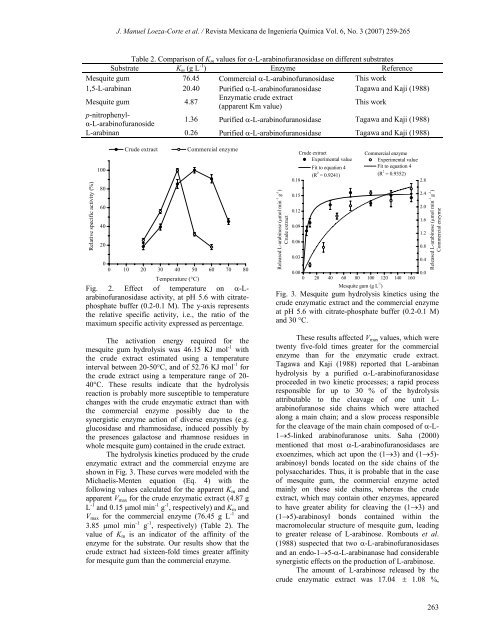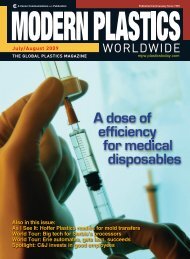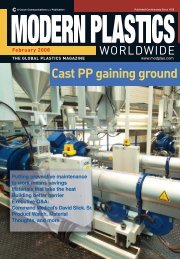amidiq - dae uptlax
amidiq - dae uptlax
amidiq - dae uptlax
Create successful ePaper yourself
Turn your PDF publications into a flip-book with our unique Google optimized e-Paper software.
J. Manuel Loeza-Corte et al. / Revista Mexicana de Ingeniería Química Vol. 6, No. 3 (2007) 259-265<br />
Table 2. Comparison of Km values for α-L-arabinofuranosidase on different substrates<br />
Substrate Km (g L -1 ) Enzyme Reference<br />
Mesquite gum 76.45 Commercial α-L-arabinofuranosidase This work<br />
1,5-L-arabinan 20.40 Purified α-L-arabinofuranosidase Tagawa and Kaji (1988)<br />
Mesquite gum 4.87<br />
Enzymatic crude extract<br />
(apparent Km value)<br />
This work<br />
p-nitrophenylα-L-arabinofuranoside<br />
1.36 Purified α-L-arabinofuranosidase Tagawa and Kaji (1988)<br />
L-arabinan 0.26 Purified α-L-arabinofuranosidase Tagawa and Kaji (1988)<br />
Relative specific activity (%)<br />
100<br />
80<br />
60<br />
40<br />
20<br />
Crude extract<br />
0<br />
0 10 20 30 40 50 60 70 80<br />
Temperature (°C)<br />
Commercial enzyme<br />
Fig. 2. Effect of temperature on α-Larabinofuranosidase<br />
activity, at pH 5.6 with citratephosphate<br />
buffer (0.2-0.1 M). The y-axis represents<br />
the relative specific activity, i.e., the ratio of the<br />
maximum specific activity expressed as percentage.<br />
The activation energy required for the<br />
mesquite gum hydrolysis was 46.15 KJ mol -1 with<br />
the crude extract estimated using a temperature<br />
interval between 20-50°C, and of 52.76 KJ mol -1 for<br />
the crude extract using a temperature range of 20-<br />
40°C. These results indicate that the hydrolysis<br />
reaction is probably more susceptible to temperature<br />
changes with the crude enzymatic extract than with<br />
the commercial enzyme possibly due to the<br />
synergistic enzyme action of diverse enzymes (e.g.<br />
glucosidase and rhamnosidase, induced possibly by<br />
the presences galactose and rhamnose residues in<br />
whole mesquite gum) contained in the crude extract.<br />
The hydrolysis kinetics produced by the crude<br />
enzymatic extract and the commercial enzyme are<br />
shown in Fig. 3. These curves were modeled with the<br />
Michaelis-Menten equation (Eq. 4) with the<br />
following values calculated for the apparent Km and<br />
apparent Vmax for the crude enzymatic extract (4.87 g<br />
L -1 and 0.15 μmol min -1 g -1 , respectively) and Km and<br />
Vmax for the commercial enzyme (76.45 g L -1 and<br />
3.85 μmol min -1 g -1 , respectively) (Table 2). The<br />
value of Km is an indicator of the affinity of the<br />
enzyme for the substrate. Our results show that the<br />
crude extract had sixteen-fold times greater affinity<br />
for mesquite gum than the commercial enzyme.<br />
Released L-arabinose (μmol min -1 g -1 )<br />
Crude extract<br />
Crude extract<br />
Experimental value<br />
Fit to equation 4<br />
(R<br />
0.18<br />
2 = 0.9241)<br />
0.15<br />
0.12<br />
0.09<br />
0.06<br />
0.03<br />
0.00<br />
0 20 40 60 80 100 120 140 160<br />
Mesquite gum (g L -1 )<br />
Commercial enzyme<br />
Experimental value<br />
Fit to equation 4<br />
(R 2 = 0.9352)<br />
2.8<br />
2.4<br />
2.0<br />
1.6<br />
1.2<br />
0.8<br />
0.4<br />
0.0<br />
Released L-arabinose (μmol min -1 g -1 )<br />
Commercial enzyme<br />
Fig. 3. Mesquite gum hydrolysis kinetics using the<br />
crude enzymatic extract and the commercial enzyme<br />
at pH 5.6 with citrate-phosphate buffer (0.2-0.1 M)<br />
and 30 °C.<br />
These results affected Vmax values, which were<br />
twenty five-fold times greater for the commercial<br />
enzyme than for the enzymatic crude extract.<br />
Tagawa and Kaji (1988) reported that L-arabinan<br />
hydrolysis by a purified α-L-arabinofuranosidase<br />
proceeded in two kinetic processes; a rapid process<br />
responsible for up to 30 % of the hydrolysis<br />
attributable to the cleavage of one unit Larabinofuranose<br />
side chains which were attached<br />
along a main chain; and a slow process responsible<br />
for the cleavage of the main chain composed of α-L-<br />
1→5-linked arabinofuranose units. Saha (2000)<br />
mentioned that most α-L-arabinofuranosidases are<br />
exoenzimes, which act upon the (1→3) and (1→5)arabinosyl<br />
bonds located on the side chains of the<br />
polysaccharides. Thus, it is probable that in the case<br />
of mesquite gum, the commercial enzyme acted<br />
mainly on these side chains, whereas the crude<br />
extract, which may contain other enzymes, appeared<br />
to have greater ability for cleaving the (1→3) and<br />
(1→5)-arabinosyl bonds contained within the<br />
macromolecular structure of mesquite gum, leading<br />
to greater release of L-arabinose. Rombouts et al.<br />
(1988) suspected that two α-L-arabinofuranosidases<br />
and an endo-1→5-α-L-arabinanase had considerable<br />
synergistic effects on the production of L-arabinose.<br />
The amount of L-arabinose released by the<br />
crude enzymatic extract was 17.04 ± 1.08 %,<br />
263









